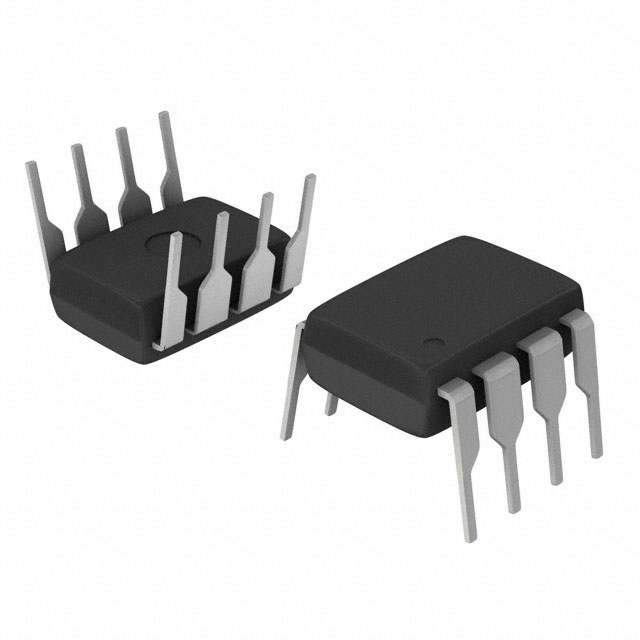Xem thông số kỹ thuật để biết chi tiết sản phẩm.

LTC1481CN8#PBF
Product Overview
Category
LTC1481CN8#PBF belongs to the category of integrated circuits (ICs).
Use
This product is commonly used in communication systems and industrial applications for data transmission.
Characteristics
- High-speed, low-power RS485/RS422 transceiver
- Supports data rates up to 20Mbps
- Operates from a single 5V supply
- Low quiescent current
- Wide common-mode range
- ESD protection on bus pins
- Available in an 8-pin plastic DIP package
Package and Quantity
The LTC1481CN8#PBF is packaged in an 8-pin plastic DIP (Dual In-line Package). It is available in quantities specified by the manufacturer.
Specifications
- Supply Voltage: 5V
- Data Rate: Up to 20Mbps
- Operating Temperature Range: -40°C to 85°C
- Input Logic Levels: CMOS/TTL compatible
- Common-Mode Voltage Range: -7V to +12V
- Quiescent Current: 300µA (typical)
Pin Configuration
The LTC1481CN8#PBF has the following pin configuration:
```
| | --| VCC |-- Pin 1 --| B |-- Pin 2 --| A |-- Pin 3 --| Y |-- Pin 4 --| Z |-- Pin 5 --| GND |-- Pin 6 --| RE |-- Pin 7 --| DE |-- Pin 8 |___________| ```
Functional Features
- High-speed data transmission: The LTC1481CN8#PBF supports data rates up to 20Mbps, making it suitable for applications requiring fast communication.
- Low power consumption: With a low quiescent current of 300µA, this transceiver helps conserve energy in battery-powered systems.
- Wide common-mode range: The device can operate with a wide common-mode voltage range of -7V to +12V, allowing for flexibility in different applications.
- ESD protection: The bus pins of the LTC1481CN8#PBF are equipped with electrostatic discharge (ESD) protection, enhancing its robustness in harsh environments.
Advantages and Disadvantages
Advantages
- High-speed data transmission capability
- Low power consumption
- Wide common-mode voltage range
- ESD protection for enhanced reliability
Disadvantages
- Limited pin count may restrict functionality in complex systems
- Requires an external power supply
Working Principles
The LTC1481CN8#PBF is designed as a high-speed RS485/RS422 transceiver. It operates by converting the differential signals on the A and B inputs into single-ended logic levels suitable for interfacing with CMOS/TTL logic circuits. The RE (Receiver Enable) and DE (Driver Enable) pins control the direction of data flow.
Detailed Application Field Plans
The LTC1481CN8#PBF finds application in various fields, including: 1. Industrial automation: Used for reliable data transmission in industrial control systems, PLCs, and motor drives. 2. Building automation: Enables communication between sensors, actuators, and central control units in smart buildings. 3. Automotive electronics: Facilitates communication between different electronic modules in vehicles, such as engine control units and infotainment systems. 4. Telecommunications: Supports data transmission in telecommunication networks, including wired and wireless infrastructure.
Alternative Models
For those seeking alternatives to the LTC1481CN8#PBF, the following models can be considered: - MAX485 - SN75176 - ADM485 - SP3485
These models offer similar functionality and are widely used in the industry.
In conclusion, the LTC1481CN8#PBF is a high-speed RS485/RS422 transceiver with low power consumption, wide common-mode range, and ESD protection. It finds application in various fields, including industrial automation, building automation, automotive electronics, and telecommunications. Alternative models such as MAX485, SN75176, ADM485, and SP3485 provide similar functionality.
Liệt kê 10 câu hỏi và câu trả lời thường gặp liên quan đến ứng dụng LTC1481CN8#PBF trong giải pháp kỹ thuật
Sure! Here are 10 common questions and answers related to the application of LTC1481CN8#PBF in technical solutions:
Q1: What is LTC1481CN8#PBF? A1: LTC1481CN8#PBF is a high-speed, low-power differential line transceiver used for data communication over long distances.
Q2: What is the operating voltage range of LTC1481CN8#PBF? A2: The operating voltage range of LTC1481CN8#PBF is typically between 4.5V and 5.5V.
Q3: What is the maximum data rate supported by LTC1481CN8#PBF? A3: LTC1481CN8#PBF supports a maximum data rate of 20 Mbps.
Q4: Can LTC1481CN8#PBF be used for half-duplex communication? A4: Yes, LTC1481CN8#PBF can be used for both half-duplex and full-duplex communication.
Q5: What is the maximum cable length supported by LTC1481CN8#PBF? A5: The maximum cable length supported by LTC1481CN8#PBF depends on various factors such as cable quality and data rate, but it can typically reach up to several hundred meters.
Q6: Does LTC1481CN8#PBF support multiple nodes on the bus? A6: Yes, LTC1481CN8#PBF supports multi-point applications with up to 32 nodes on the bus.
Q7: Is LTC1481CN8#PBF compatible with RS-485 standard? A7: Yes, LTC1481CN8#PBF is fully compliant with the RS-485 standard.
Q8: Can LTC1481CN8#PBF be used in industrial environments? A8: Yes, LTC1481CN8#PBF is designed to operate reliably in harsh industrial environments with high noise immunity.
Q9: What is the power consumption of LTC1481CN8#PBF? A9: The power consumption of LTC1481CN8#PBF is typically low, making it suitable for battery-powered applications.
Q10: Are there any application notes or reference designs available for LTC1481CN8#PBF? A10: Yes, Linear Technology (now part of Analog Devices) provides application notes and reference designs that can help in implementing LTC1481CN8#PBF in various technical solutions.
Please note that the answers provided here are general and may vary depending on specific requirements and use cases. It is always recommended to refer to the datasheet and relevant documentation for accurate information.

